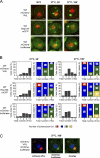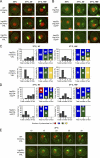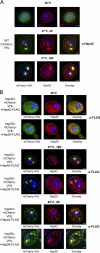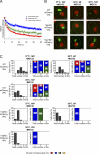Hsp42 is required for sequestration of protein aggregates into deposition sites in Saccharomyces cerevisiae
- PMID: 22065637
- PMCID: PMC3257523
- DOI: 10.1083/jcb.201106037
Hsp42 is required for sequestration of protein aggregates into deposition sites in Saccharomyces cerevisiae
Abstract
The aggregation of proteins inside cells is an organized process with cytoprotective function. In Saccharomyces cerevisiae, aggregating proteins are spatially sequestered to either juxtanuclear or peripheral sites, which target distinct quality control pathways for refolding and degradation. The cellular machinery driving the sequestration of misfolded proteins to these sites is unknown. In this paper, we show that one of the two small heat shock proteins of yeast, Hsp42, is essential for the formation of peripheral aggregates during physiological heat stress. Hsp42 preferentially localizes to peripheral aggregates but is largely absent from juxtanuclear aggregates, which still form in hsp42Δ cells. Transferring the amino-terminal domain of Hsp42 to Hsp26, which does not participate in aggregate sorting, enables Hsp26 to replace Hsp42 function. Our data suggest that Hsp42 acts via its amino-terminal domain to coaggregate with misfolded proteins and perhaps link such complexes to further sorting factors.
© 2011 Specht et al.
Figures








Similar articles
-
A prion-like domain in Hsp42 drives chaperone-facilitated aggregation of misfolded proteins.J Cell Biol. 2018 Apr 2;217(4):1269-1285. doi: 10.1083/jcb.201708116. Epub 2018 Jan 23. J Cell Biol. 2018. PMID: 29362223 Free PMC article.
-
Spatially organized aggregation of misfolded proteins as cellular stress defense strategy.J Mol Biol. 2015 Apr 10;427(7):1564-74. doi: 10.1016/j.jmb.2015.02.006. Epub 2015 Feb 11. J Mol Biol. 2015. PMID: 25681695 Review.
-
Hsp42 is the general small heat shock protein in the cytosol of Saccharomyces cerevisiae.EMBO J. 2004 Feb 11;23(3):638-49. doi: 10.1038/sj.emboj.7600080. Epub 2004 Jan 29. EMBO J. 2004. PMID: 14749732 Free PMC article.
-
Syntaxin 5-dependent phosphorylation of the small heat shock protein Hsp42 and its role in protein quality control.FEBS J. 2023 Oct;290(19):4744-4761. doi: 10.1111/febs.16886. Epub 2023 Jun 20. FEBS J. 2023. PMID: 37306264
-
Role of sHsps in organizing cytosolic protein aggregation and disaggregation.Cell Stress Chaperones. 2017 Jul;22(4):493-502. doi: 10.1007/s12192-017-0762-4. Epub 2017 Jan 24. Cell Stress Chaperones. 2017. PMID: 28120291 Free PMC article. Review.
Cited by
-
Regulation of protein homeostasis in neurodegenerative diseases: the role of coding and non-coding genes.Cell Mol Life Sci. 2015 Nov;72(21):4027-47. doi: 10.1007/s00018-015-1985-0. Epub 2015 Jul 21. Cell Mol Life Sci. 2015. PMID: 26190021 Free PMC article. Review.
-
Inactive Proteasomes Routed to Autophagic Turnover Are Confined within the Soluble Fraction of the Cell.Biomolecules. 2022 Dec 30;13(1):77. doi: 10.3390/biom13010077. Biomolecules. 2022. PMID: 36671462 Free PMC article.
-
Ubiquitin Ligase Redundancy and Nuclear-Cytoplasmic Localization in Yeast Protein Quality Control.Biomolecules. 2021 Dec 3;11(12):1821. doi: 10.3390/biom11121821. Biomolecules. 2021. PMID: 34944465 Free PMC article. Review.
-
Dynamic Regulation of the 26S Proteasome: From Synthesis to Degradation.Front Mol Biosci. 2019 Jun 7;6:40. doi: 10.3389/fmolb.2019.00040. eCollection 2019. Front Mol Biosci. 2019. PMID: 31231659 Free PMC article. Review.
-
The noncanonical small heat shock protein HSP-17 from Caenorhabditis elegans is a selective protein aggregase.J Biol Chem. 2020 Mar 6;295(10):3064-3079. doi: 10.1074/jbc.RA119.011185. Epub 2020 Jan 30. J Biol Chem. 2020. PMID: 32001616 Free PMC article.
References
-
- Abelson J.N., Guthrie C., Fink G.R. 2003. Guide to Yeast Genetics and Molecular Biology. Academic Press, New York: 933 pp
-
- Arrigo A.P. 2000. sHsp as novel regulators of programmed cell death and tumorigenicity. Pathol. Biol. (Paris). 48:280–288 - PubMed
-
- Ayscough K.R., Stryker J., Pokala N., Sanders M., Crews P., Drubin D.G. 1997. High rates of actin filament turnover in budding yeast and roles for actin in establishment and maintenance of cell polarity revealed using the actin inhibitor latrunculin-A. J. Cell Biol. 137:399–416 10.1083/jcb.137.2.399 - DOI - PMC - PubMed
Publication types
MeSH terms
Substances
LinkOut - more resources
Full Text Sources
Other Literature Sources
Molecular Biology Databases

